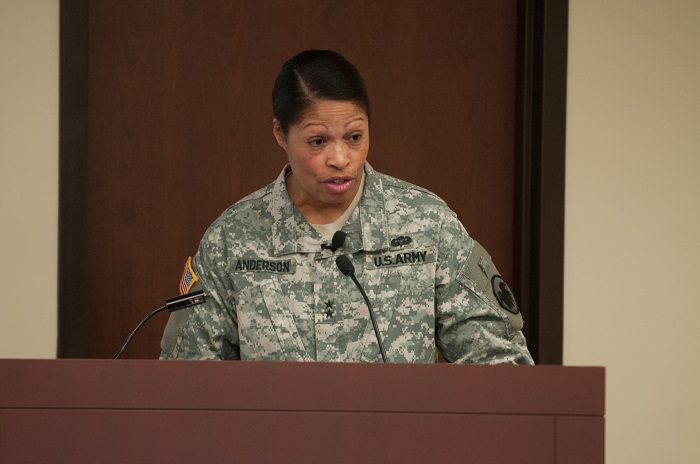
Maj. Gen. Marcia M. Anderson, right, the deputy chief, U.S. Army Reserve, was the guest speaker at a Women's History Month observance at the U.S. Army Reserve Command headquarters at Fort Bragg, N.C., March 25, 2014. Anderson, the Army's first African American female major general highlighted the accomplishments of women dating back to the Revolutionary War and the current evaluation process of opening previously closed military occupations to women. The appearance of U.S. Department of Defense (DoD) visual information does not imply or constitute DoD endorsement. 1194495. Public domain.
Today, in honor of women's history month, we release Marcia Anderson's oral history recording and transcript to the public. Anderson overcame obstacles by requesting positions held historically by men in the Army, demonstrating professional excellence on objective Army standards, knowing her profession better than her peers, and drawing on the support of her family's strong military tradition. The following summarizes the phone interview conducted on August 12, 2020, in the middle of the Covid-19 Pandemic. Interspersed in the text are audio clips from the interview. Click Marcia Anderson's Interview to listen to the complete interview with a searchable transcript.
In this oral history interview, Marcia Anderson recalls her service in the United States Army from May 1979 to August 2016. She was the first African American woman to achieve the rank of major general in the United States Army.
Anderson is the daughter of Arlayne Mahan, who worked in the billing department at the Beloit Wisconsin Hospital, and Rudolph Mahan, a Korean War veteran who worked at the Beloit Corporation. Her parents divorced when she was one year old, and they ended up living with her maternal grandparents in Beloit. She attended Merrill Grade School, was held back for kindergarten, and attended first grade at Catholic School in Beloit: Our Lady of the Assumption. Anderson enjoyed playing war with the boys outdoors.
Anderson moved from Beloit, Wisconsin, to East St. Louis, Illinois, at eight. Anderson notes the culture change with the St. Louis area having one foot in the North and one foot in the South. She explains that East St. Louis went through a substantial economic downturn and population shift while attending Catholic grade and high schools. Her mother emphasized the importance of education and felt that Catholic schools were the best available. Anderson read avidly the numerous books and magazines that her mother made available. The family had multiple subscriptions to magazines and made Saturday trips to the library.
She attended Xavier High School in St. Louis and then Rosati-Kain High School, an all-girls Catholic high school. Her mother was one of the first African American women to integrate at Rosati-Kain in the 1950s. Anderson’s honors courses meant that she had completed her high school requirements a half-year early.
She then sought and got permission to attend college at Southern Illinois University-Edwardsville while in high school. By the time she had graduated from high school, she had enough credits for college sophomore status. Anderson states that her reading and comprehension skills formed the basis for her future success, and being held back in kindergarten drove her to excel academically.
In the late 1960s, while living in East St. Louis, Anderson experienced the assassinations of John F. Kennedy, Martin Luther King, Jr., and Robert F. Kennedy through the evening news broadcast. Anderson shares that each of these assassinations hit her family hard; they had a different reaction to each one. She remembers that following King's assassination their family life “kind of stopped.” Her grandfather predicted that riots would follow due to pent-up anger.
Upon her high school graduation in May of 1976, Anderson enrolled as a sophomore at Creighton University in Omaha, Nebraska. In addition to Creighton being a private Catholic University, Anderson says that she had uncles on the faculty who could look out for her. Anderson started her military career when she saw an empty line at class registration and decided to take military science. She relates how she became interested because of the $100 stipend. Her uncle said after finding out she had enrolled in the Reserve Officers Training Corps (ROTC), "Well, you know that's the Army?”
Her father was intensely proud of her getting a commission as a second lieutenant and the opportunities available to officers. Anderson's father volunteered for the Korean War, and similarly, Uncle Odell Niblett volunteered for Vietnam. Anderson scored high enough to go on active duty; however, she decided to go with the Reserves.
Anderson reported to Fort Benjamin Harrison, Indiana, for Adjutant General and Personnel Officers Basic Course. In November 1979, two days before she reported to Fort Benjamin Harrison, the Iran Hostage Crisis began, and many new officers assumed we would be at war with Iran shortly.
Following officers basic, Anderson served with the 1st Squadron, 322nd Armored Cavalry Regiment out of Omaha, Nebraska, that did its annual two-week rotations at Fort Knox, Kentucky. This required some adjustment by the unit as they had no females in their armored unit. Anderson recalls her commander continually trying to send her up to brigade headquarters in Lincoln, Nebraska. Anderson declined reassignment to Lincoln. The S-1 position that Anderson held the Army coded for neither male nor female. During this time before law school, as civilian occupation, Anderson worked at a Kellogg cereal plant in Omaha, Nebraska.
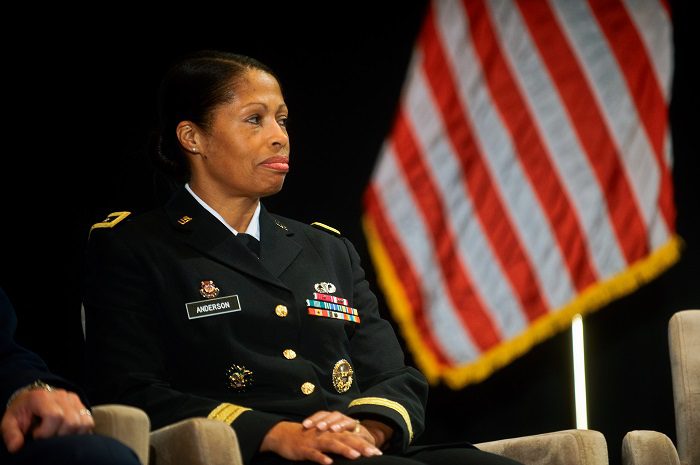
U.S. Army Maj. Gen. Marcia Anderson, representing the Army Reserve on behalf of its chief, participates in the Reserve chiefs panel at the Reserve Officers Association National Security Symposium, Washington, D.C., Aug. 9, 2013. The appearance of U.S. Department of Defense (DoD) visual information does not imply or constitute DoD endorsement. 993215. Public domain.
Later, Anderson went on standby status. To meet her service obligation, Anderson worked at the Reserve Components Personnel and Administration Center (RCPAC) in St. Louis, working for a major. She took her PT Test and scored at 300 and 360 on the extended scale; Anderson requested to go to Airborne School. She wrote her own orders, and the major signed off on sending her to Airborne School. Anderson spent her summers doing her Reserve rotations at the RCPAC and at the Judge Advocate General Office (JAG) at Fort Benjamin Harrison. While at Harrison, she observed a couple of court-martials more in line with her soon-to-be legal career.
Getting into Airborne School
Anderson served for a couple of years in the Reserve and then decided to go to law school and went on Individual Ready Reserve (IRR). An African American woman in East St. Louis who had five children was an attorney and was an Illinois state representative positively influenced Anderson's decision to attend law school. In addition, her political science background and interest in government also strongly influenced that decision. Anderson could have chosen nearby Creighton University for law school, but instead, she attended Rutgers School of Law at the Newark Campus in New Jersey from 1981 to 1984. The experience of Anderson moving to the East Coast from the Midwest was quite a change. She relates some of her experiences in Newark, New Jersey, still recovering from the riots of the 1960s and drug activity of the 1980s.
Why I became an attorney
Following law school, Anderson worked for a New Jersey law firm that defended companies sued by the Environmental Protection Agency (EPA) for pollution violations. From 1985 to 1998, Anderson served with the 98th Training Division in the Reserves that conducted basic training and one-unit station training for their annual training. Anderson deployed to Fort Benning, Georgia, for her annual training and spent various amounts of time on active duty. She sought leadership positions as they became available. One of the partners at the law firm understood the need for Anderson to drill annually and made it easier for her to set aside time for annual training. While in the 98th Division, Anderson held positions as battalion executive officer and company commander of a basic training unit.
Because of gender regulations at the time, Anderson commanded a logistical or transportation company instead of an infantry company. According to Anderson, she would be the first female in the division to command a company. As Anderson tells it, she had to serve as battalion S-4 in order to command a company later as part of the deal she made with the brigade commander. Anderson’s battalion commander was not happy about having a female company commander. Once in command, Anderson’s drill sergeants were skeptical; however, after she maxed the PT test with scores off the chart, the drill sergeants did not have anything to say. She found that ensuring the metrics could be objectively measured that she was doing objectively well that it would be difficult to say negative things about her performance. She found that this technique served her well throughout her career.
Anderson encountered sexual harassment and outright hostility in different forms throughout her career. Anderson initially avoided active duty and instead chose reserve duty because she knew she would not tolerate what she had gathered from her peers regarding harassment while on active duty. In the interview, Anderson relates more than one story of inappropriate advances rebuffed and superiors taken aside, talked to, and sending back-channel warnings to those who acted inappropriately in the workplace. Throughout these incidents, Anderson, though an officer, found her non-commissioned officer chain of command supportive of her efforts.
Anderson next went on to New York City to become clerk of the court for the United States Court of Appeals for the Second Circuit from 1985 to 1987. This federal court handles federal appeals from New York, Connecticut, and Vermont. The clerk of the court is “like the CEO for the court,” responsible for and manages many areas, including people who handle personnel, procurement, information technology, and financial matters. From 1987 to 1990, Anderson worked as the supervising staff attorney for this appellate court. She assisted the judges and their staff with the workflow and moved on when few upward mobility opportunities appeared.
Clerk of the Court responsibilities
While discharging the duties as clerk of the court and through her position later in Boston until 1998, Anderson served as a member of her New Jersey reserve unit, the 98th Division. Anderson recalled that during her time, the 98th Division had been the 78th Division merged into the 98th, and at some point, it had even been the 76th Division in the interim reorganization. As a senior captain, Anderson acted as project auditor for the commanding general. On promotion to major, Anderson became battalion S-3 of one of the training battalions. She got to plan the entire annual training exercise for the brigade at Fort Dix, New Jersey, and points out that normally Army officers branched Adjutant General do not get these planning roles historically held by infantry officers. However, as Anderson points out, she continually tried to get experience in positions that earlier women in the Army would not have been allowed to fill.
Following the supervising staff attorney position, Anderson joined the law firm of McElroy, Deutsch, and Mulvaney, from about 1990 to 1996. She followed that position with the Deputy General Counsel for Jersey Central Power and Light, subsidiary of General Public Utilities and owner of the Three-Mile Island nuclear power plant still in litigation following the accident in 1979.
Anderson then applied for and received a position in the federal court system in Boston, Massachusetts, with the First Circuit Court. There Anderson set up the office of the specialized bankruptcy appellate panel. She managed the caseload of specialist judges and staff reviewing the appeals. During this time, Anderson got an Executive Officer/S-3 position in a Reserve unit at what base realignment left of Fort Dix, New Jersey. That unit focused on educating non-commissioned officers (NCOs) about personnel and postal job skills.
At the time, Anderson decided she needed to move to Wisconsin for her father. In 1998, Anderson applied for an open position in Madison for Clerk of the Bankruptcy Court, and judges selected her for their new Clerk of Court. As clerk of court, she had an operational staff and managers who worked for her who handled finance, procurements, information technology, and human resources.
On the military side initially, Anderson served with the 95th Training Division out of Oklahoma City, and she served soon after with the 84th Training Division out of Milwaukee. While serving with the 84th Division, Anderson held the following positions G-1, brigade command, and G-3 staff. As brigade commander, Anderson was responsible for the instructors and the instruction for several states that taught officer professional education, Command and General Staff College, and intermediate training for junior officers.
Anderson talks at length about her experience planning, mentoring, and structuring training units. She observes that much of the time she spent off the clock talking to training NCOs and others responsible for the training. Anderson's active time management was critical to her success as a field grade officer. During her lunch hour, she remembers spending time doing her work for Command and General Staff College and the War College, continuous education on nights and weekends opposite her civilian occupation. When asked about the differences between active duty and reserve/guard soldiers, Anderson was more interested in whether the individual could do the tasks necessary to get the work done. Additionally, she found that some individuals had the skills and ability to do the work regardless of active or reserve status; others did not, regardless of rank. The reserve/guard units brought a fresh way of looking at things and often had more relevant skill sets than the active-duty soldiers.
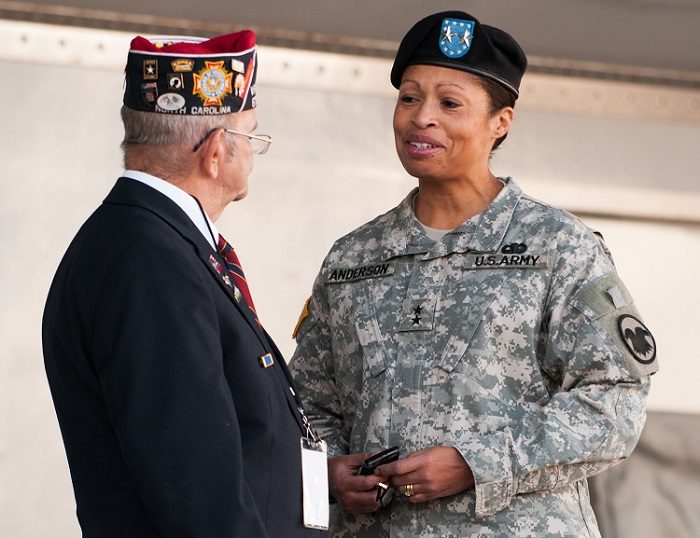
Maj. Gen. Marcia M. Anderson, right, deputy chief, U.S. Army Reserve, talks with Harvey E. Stewart, Sr., past commander of All American Veterans of Foreign Wars Post 670, prior to the start of the 2012 Fayetteville Veterans Day parade, Nov. 10, in Fayetteville, N.C. The annual parade featured U.S. Army Reserve Command soldiers and service members and equipment from the 18th Airborne Corps, 82nd Airborne Division, high school bands, decorated floats, veteran's organizations and Junior Reserve Officer Training Corps marching units. The appearance of U.S. Department of Defense (DoD) visual information does not imply or constitute DoD endorsement. 780364. Public domain.
As she rose in rank, Anderson encountered gender discrimination in the Army as she observed fewer and fewer women. At the time, she would be the only woman present in the room, and often her male peers had to adjust to her presence and change the content of their conversations. Anderson recalls some of her experiences, including failure to salute an officer and inappropriate advances in 2001. Issues that frustrated Anderson included men who would restate her earlier idea and then take credit for it and male peers who flat out told her she did not belong in the Army. Within the Army subculture, Anderson had to disabuse peers of the notion that though she was not the chattiest person in the room, that did not lessen her leadership credentials. She was going to respond deliberately and thoughtfully.
In terms of racial discrimination, Anderson retells stories from her father, a Korean War veteran, who encountered discrimination in a newly integrated military and found an ally in a colonel. From that time forward, Anderson’s father liked colonels and generals and proudly pinned on her colonel rank.
Anderson started her War College course in July 2001. At the time, she was Deputy G-3 of the 84th Training Division. Following the Tuesday, September 11, 2001, attacks, by Thursday, Anderson was in Fort Benning, Georgia, getting her unit ready for mobilization. As such, Anderson put her deputy in charge of Clerk of Court in Madison. While at Fort Benning, Anderson coordinated and planned for a brigade of the 84th Division to move to Fort Benning, along with all the necessary logistical, physical, and personnel resources, in just ten days. However, that deployment did not occur.
After about eighteen months as Deputy G-3, Anderson applied for brigade command, and the Army assigned her to command 6th Brigade, 95th Training Division, Topeka, Kansas. Anderson explains that it is more expensive often for a reservist/guard member to get to weekend drill and annual training than one receives in pay for that time, but they do it. In addition, cheap housing for the weekend drill was precious, as were low-cost flights. In this same vein, Anderson talks about how the perception of the reservist versus active-duty personnel shifted after 9/11 from the second tier to the first tier. Those reservists were no longer weekend warriors.
Anderson still commanded the brigade in 2007, when the commanding general of the 95th Division asked her to come over and be his Assistant Division Commander, Operations (ADCO); she was a colonel in a brigadier general’s slot. At the time, Anderson put in her papers for brigadier general, but she did not expect to make the list without an overseas combat deployment. On February 15, 2008, Anderson received the call that she had been nominated to the brigadier generals’ list. Anderson called her grandmother and family to let them know the good news.
Brigadier General rank pinning
It was essential to Anderson that she involved as much of her family and friends as possible in the Madison community. The swearing-in ceremony was held in the Wisconsin legislative chamber. On March 15, 2008, Anderson’s father, Rudolph Mahan (a veteran), and her husband, Amos Anderson (a veteran), pinned on Anderson’s star rank insignia. Her brother, Barry Mahan (a veteran), presented her with her service weapon; a retired Air Force friend (a veteran) presented her general officer's flag; and long time mentor, Brigadier General Robert Cocroft (ret.), swore her in. At the time, Anderson was the second African American woman to be promoted to Brigadier General in the Reserves. During the ceremony, Anderson recognized the sacrifices of those women and people of color who came before her, laying the groundwork for her promotion to brigadier general. Anderson had two swearing-in ceremonies, one in Madison and one in Arlington Heights, Illinois, her reserve unit affiliated with First Army West.
In her new role, she was dual-hatted. She was Deputy Commanding General, First Army West, and commanding general of the 85th Support Command. The Deputy Commanding General First Army West was responsible for mobilization training of Reserve and National Guard members of the Air Force, Army, Navy, Marines, and Coast Guard. Whereas the with command of the 85th Support Command, she was responsible for six to eight brigades run by active-duty colonels filled with Reserve soldiers and a mixture of active-duty soldiers. Anderson explains that though a member of the Reserves, she spent much of her time on active duty at various duty stations throughout the United States. She would put herself on active duty and then take herself off active duty as necessary to complete the necessary work. The mission ensured readiness and mobilized those service members for tours in Iraq and Afghanistan. Anderson had a general staff in Arlington Heights that helped her oversee all these people.
Leadership philosophy
As she explains it, she thoroughly believed in empowering people to do their jobs and then getting out of the way and letting them do it. She also sought out those individuals who had the talents to get the job done and did not necessarily care if the individual was enlisted or an officer. Her concern for junior service members repeatedly appears in her interview. While at Arlington Heights, Anderson found an ally in Command Sergeant Major Paul Bianco. Also, at First Army West, the commanding general was Lieutenant General Russel Honoré, whom Anderson praises for his actions in New Orleans following Hurricane Katrina and how he kept things in perspective with the real world sacrifices his soldiers made.
Anderson explains that the election of President Barack Obama initially did affect how people looked at her. There were also hopes that the election of the first African American president would lead to substantial changes in the military. Anderson then talks about her experience learning about the other branches, their customs, and terminology through Advanced Joint Professional Military Education in 2009. She accidentally sat in the captain's chair on a Navy aircraft carrier and was asked to find another chair. Next, Anderson talks about her time serving on the Wisconsin Veterans Affairs Board and why she joined. She also provides her perspective on the issues surrounding then-Department of Veterans Affairs Secretary John Scocos.
On cultivating relationships
As she explains it, she thoroughly believed in empowering people to do their jobs and then getting out of the way and letting them do it. She also sought out those individuals who had the talents to get the job done and did not necessarily care if the individual was enlisted or an officer. Her concern for junior service members repeatedly appears in her interview. While at Arlington Heights, Anderson found an ally in Command Sergeant Major Paul Bianco. Also, at First Army West, the commanding general was Lieutenant General Russel Honoré, whom Anderson praises for his actions in New Orleans following Hurricane Katrina and how he kept things in perspective with the real world sacrifices his soldiers made.
Anderson explains that the election of President Barack Obama initially did affect how people looked at her. There were also hopes that the election of the first African American president would lead to substantial changes in the military. Anderson then talks about her experience learning about the other branches, their customs, and terminology through Advanced Joint Professional Military Education in 2009. She accidentally sat in the captain's chair on a Navy aircraft carrier and was asked to find another chair. Next, Anderson talks about her time serving on the Wisconsin Veterans Affairs Board and why she joined. She also provides her perspective on the issues surrounding then-Department of Veterans Affairs Secretary John Scocos.
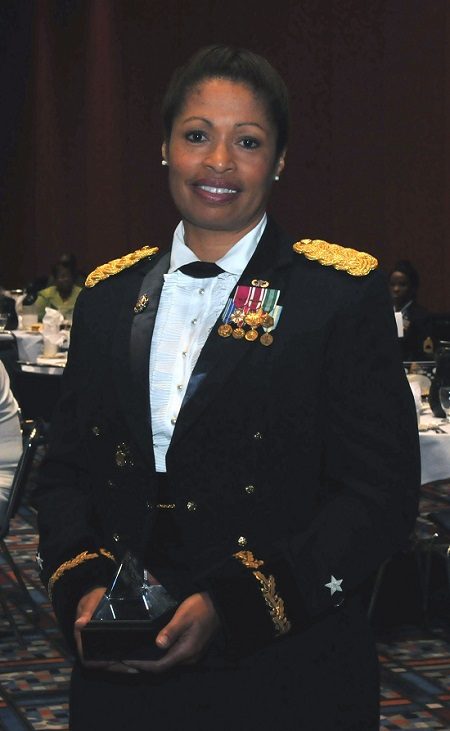
In this image released by the United States Army Reserve Command, Maj. Gen. Marcia Anderson and others participate in a veterans recognition dinner in Houston, Texas, Tuesday, July 10, 2012. The event was held in conjunction with the annual conference of the National Association for the Advancement of Colored People. As part of the banquet, Anderson was presented with the Benjamin J. Hooks Distinguished Service Award for her efforts in promoting equal opportunity. During her visit to the conference, Anderson highlighted Army efforts to help current and former service members transition into the civilian job market. The appearance of U.S. Department of Defense (DoD) visual information does not imply or constitute DoD endorsement. 622139. Public domain.
Anderson next became the Deputy Commanding General of the Army Human Resources Command, and she moved from Madison to Fort Knox, Kentucky, a position that she said she enjoyed. She served on active duty as deputy commander and saw several new units move to Fort Knox and the Armor School move to Fort Benning. She replaced Major General William Razz Waff, a good friend and someone who shared a concern for taking care of soldiers. The Army's Human Resources Command covered everything human resources from recruitment to retirement, and her job was to assist the commanding general with Reserve and Guard issues. Anderson also worked with Lieutenant General Benjamin Freakley in Accessions Command on recruiting and personnel.
Anderson also worked with General Jack Stultz, Jr., on the Continuum of Service Project. The concept was to better dovetail the Reserve and Guard components into an overall vision of the military instead of the Cold War version that favored the active component over the reserve component. This need became apparent after 9/11, with the Reserve and Guard units serving years on active duty. However, the service model had not caught up with the Reserve and Guard units' integral role; they had become part of the team. This all-inclusive project addressed these units' roles by changing the regulations to anticipate employers’ needs, required travel, medical care, and military career progression.
On October 1, 2011, Anderson found out that she would be promoted to major general. She would have her promotion ceremony in front of the entire human resources and accession command at Fort Knox, hosted by Lieutenant General Freakley. She again acknowledged those who came before her during the ceremony. Anderson became the first African American woman in the United States Army promoted to major general.
In terms of leadership advice to other African American women, Anderson felt that they should be open to those who sincerely want to help them and accept their help instead of resisting it. She also thought that one should not be too hard on oneself, "don't beat yourself up eternally for a mistake you made thirty years ago." Reflecting, she thinks that having people not dislike you beforehand provides a better chance of them working with you in the future, so do not burn bridges. Her advice is to develop and cultivate relationships, do the groundwork before the meeting. Finally, Anderson thinks it is vital to seek out those quiet people in the back of the classroom who are good listeners and collaborators and need to be encouraged to be leaders. She felt she should have been more encouraged by her teachers even though she was not a popular kid or an athlete. Anderson states that the Army made her more assertive by putting her in leadership roles that challenged her.
Meeting with the Army Chief of Staff
In 2011, Anderson attended the Capstone General and Flag Officer course that brought together her peers of other service branches. The Chief of the Army Reserve decided that Anderson was going to be his deputy, and that is how Anderson became Deputy Chief Army Reserve (DCAR) working at the Pentagon. Anderson’s duties included representing the Chief of Army Reserve (CAR), attending Chief of Staff of the Army briefings, entering the Sensitive Compartmented Information Facility (SCIF), and acting deputy/acting secretary for training mobilization and readiness. She explains the two hats the Chief of Army Reserve wore, Commanding General United States Army Reserve Command and Chief of Army Reserve.
In 2014, Anderson returned to Madison. Lieutenant General Jeffrey Talley had offered her a commanding general position, but she wanted to return to her family and her court family in Wisconsin. Anderson decided she had done enough serving her country and was not looking for a full-time position. There were things she wanted to do back in the courts in Madison. In her own words, “I went to the Pentagon, I was 6'5". And when they got done with me, I was 5'6".” Anderson was in a holding pattern for about two years, looking for Army projects that would work for her, it did not work out, and she retired from the Army in 2016. Specifically, she cites that having President Obama's signature on her retirement certificate was essential to her, and she wanted others to see a retirement ceremony. Anderson held a retirement party that included her family and court family at the courthouse in Madison. She maintains relationships with those she served, including Command Sergeant Major Bianco, Lieutenant Colonel Larry Waldhart, General Waff, and Master Sergeant Mabel Holmes.
Anderson talks at length about how initially, the wars in Iraq and Afghanistan drew heavily from Reserve and Guard units because they had specialties the active forces did not have. This was a good thing to draw these two types of forces together as one force in her mind. However, with the later drawdown in forces in Iraq and Afghanistan, she began to observe the separation of these two types of forces that had once closely intertwined just a few years earlier.
In terms of her leadership philosophy, Anderson says to listen to others, mentor them, empower them, and allow them as many opportunities to excel as possible. Simultaneously, she says, be aware of one’s own biases.
When asked about mentors, Anderson named four people. The first, Brigadier General Robert Cocroft, retired and now deceased, could be very blunt, had a good heart, a strong work ethic, and taught "me not to sell myself short." Next would be Chief Judge Robert Martin, retired; he was also blunt and wanted to know what impact a new policy had on the staff. Next, Anderson names her husband Amos Anderson for the ability to make hard personal decisions and be direct with people. Lastly, she points to Command Sergeant Major Bianco, who could tell the truth, be practical, innovative, and look out for the soldiers' and families' interests.
Anderson remembers that the military largely relegated women to minor or limited leadership roles when she entered the Army. She sees a more diverse force as a better-prepared force. She now sees how leadership is changing with women in combat leadership roles and particularly those serving in special forces. Anderson does not think it may be necessary for an individual to be in combat arms in order to be a good leader; however, the existing system has favored those from the combat arms branches over those in the combat support or service support branches. She thinks that leaders come in all "shapes and sizes" and sees a day when a woman sits as the chair of the Joint Chiefs.
Following in the footsteps
Anderson reflects that race relations have improved since she joined the Army in 1979 but that there is still much work to be done. She feels that people of color are often not given those career positions that prepare them for the next step in career progression based upon their color. Anderson argues in favor of the opportunity for people of color to hold these positions so that they can stay on that career pathway. From a historical standpoint, Anderson sees herself as just one more step along the way, following in the footsteps of the all-African American 6888th Central Postal Battalion, Women’s Army Corps (WAC), that served in World War II. Regarding this topic, Anderson quotes Wynton Marsalis, “Excellence is a form of protest.” She says that other people in the military told her that her presence made a difference in their decision to stay in the military: it gave them hope.
Anderson talks about the murder of George Floyd, how it affected her, reminded her of her police stops, and started a conversation with her friend Command Sergeant Major Bianco, now a police officer. She thinks it is an important time for people to sit down and discuss race, collaborate, and think about inequalities and how to address them. During the interview, Anderson details two police stops she thinks were racial profiling. The first one happened while she lived in New York City and traveled to Vermont with two white friends going on a bike trip. Anderson was the only one the officers pointed a gun at, and to this day, her heart races when the red and blue lights go on behind her. The second time she was stopped in a traffic circle in New Jersey doing fifteen miles an hour. Anderson had just left the car dealership with the car she had purchased and was driving it home. The officer demanded she open her trunk; she declined and asked the officer to get a warrant. She was concerned about the officer planting drugs in the trunk, an act she became familiar with while working in law school. Anderson thinks that this was also racial profiling, given that it was across from a housing project.
Sponsor of the USS Beloit (LCS-29)
On a concluding note, Anderson talks about serving with various organizations in the Madison area, including Active Community Health, the United Way, and Women in Focus. In addition, Anderson talks about her role serving on the Green Bay Packers board of directors. She says that it is an excellent board that makes decisions about representing the state and supporting the surrounding communities. She also reveals that she is the sponsor for the littoral combat ship USS Beloit (LCS-29). Anderson talks about her role as a sponsor: putting her initials permanently on the ship's keel and placing some object aboard the ship for the ship's commissioned service life.
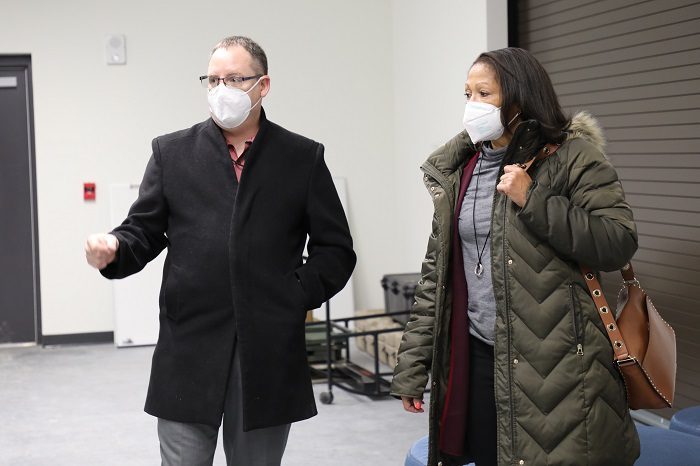
Retired Maj. Gen. Marcia Anderson, civilian aide to the Secretary of the Army (CASA) for Wisconsin, visited Fort McCoy on Feb. 8, 2022. Anderson visited Fort McCoy to discuss current operations, capabilities, and future plans at the installation. Her visit included a tour of Fort McCoy simulation and training areas. The appearance of U.S. Department of Defense (DoD) visual information does not imply or constitute DoD endorsement. 7048175. Public domain.

